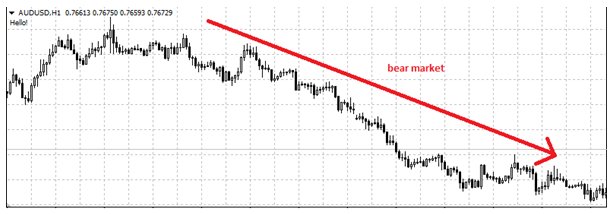Understanding Bull and Bear Markets

A bull market is used to describe a situation where prices are rising, thereby encouraging many traders to buy the asset, potentially leading to further price increases.
Bear markets refer to a market situation when prices are falling, leading to selling of the asset by traders, thereby encouraging more selling.
Why is it important for traders to understand bull and bear markets? Forex is a bi-directional market in which traders may achieve success by either buying or selling a currency pair. Success may be achieved therefore, if the market is bullish or bearish. Knowing the direction that the market is taking will enable traders to know how to place orders that follow the trend. Placing orders against the trend may be risky and can more easily end in failure than orders which follow the trend. As we can see from this snapshot below, some trends can last for a very long time. This here, is an example of a bear market.
From this snapshot, we can also see that the market may not simply head in a straight line all the way down (or up if the market was bullish). Rather, there are a few bumps along the way. This is usually caused by traders taking some profit along the way, forcing prices to briefly go the opposite way to the trend due to transient oversupply. Some traders may mistake this for trend reversal, get into the trades and then get themselves completely burnt when prices resume their movement in the direction of the trend.
How to Understand Bull and Bear Markets
This is why the first step in understanding bull and bear markets is to understand where the trend really is headed. If this step is not taken care of, everything else may collapse.
Bear markets are characterised by lower highs and lower lows, while bull markets are characterized by higher highs and higher lows. In between, there will be dips in a bull market and rallies in a bear market. Most of us, indeed no trader, has the ability to correctly pick out the exact point where a trend starts and ends. Most trades will therefore be placed somewhere within a trend. The best places may therefore be where these dips and rallies occur. Traders should therefore hone their skills in the areas of trend identification as well as picking strategies to detect the best areas on a dip to buy in a bull trend, or the best area to sell on a rally during a bear market.
a) Trend Identification
The best way to identify the trend may be to open a daily chart. The daily chart shows price activity for several weeks and months (depending on how much of the zoom tool you use). It is thus a great way to detect a trend. Once you have lower lows and lower highs (bear market) or higher highs and higher lows (bull market), you have got the trend.
b) Where to Buy and Sell Within a Bull/Bear Market
To potentially profit from a bull market, you may buy on a dip of price. For a bear market, you can sell on a transient rally. This is easier said than done. One of the strategies that can be used is the Fibonacci retracement and extension tools. The retracement tool shows levels to which price can possible dip or rally to within a bull or bear market, while the extension tool shows the extent to which a trade based on a dip-buy or a rally-sell order could move before exhaustion.
There are other tools to identify these possible trade areas. However, it is the job of the trader to use a demo account to identify how these tools are used. But the basic principles of trades within a bear or bull market are the same for all currency pairs.
Find more: Contributing Authors






























